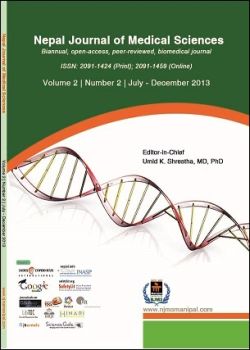Evaluation of association of fragility fracture and bone mineral density in Nepalese population
DOI:
https://doi.org/10.3126/njms.v2i2.8956Keywords:
Bone mineral densitometer, fragility fracture, osteoporosis, T-scoreAbstract
Background: Fragility fractures are one of the major health problems. Many factors are associated with it some of which are modifiable and some are not. If we know the value of T-score at which fragility fracture occurs and associated factors responsible for fragility fracture than we will be able to control this burden to the society. The objective of this study is to determine association between fragility fracture and bone mineral density (BMD) using bone densitometry and to know the value of T-score at which fragility fracture occurs.
Methods: Patients presenting to B.P. Koirala Institute of Health Sciences with fragility fracture of distal end of radius, fracture around hip and vertebral fractures were included in the study to know the value of T-score at which fragility fracture occurs and their associated risk factor. Patients less than 50 years of age, high energy trauma fracture and pathological fractures were excluded from the study.
Results: We found that being multipara, smoking, alcohol consumption, post-hysterectomized patients and steroid intake had significant association with fragility fracture. There was no association with religion, geographic location, associated medical illness, age, sex, associated injury and site of injury.
Conclusion: The patients with risk factor for fragility fracture like smoking, alcohol consumption, multipara women, post-hysterectomized women and those who are on long term steroid therapy should undergo BMD test and the value at -3.254 are prone to fragility fracture and should be treated accordingly.
Nepal Journal of Medical Sciences | Volume 02 | Number 02 | July-December 2013 | Page 130-134
Downloads
Downloads
Published
How to Cite
Issue
Section
License
Copyright © by Nepal Journal of Medical Sciences. The ideas and opinions expressed by authors of articles summarized, quoted, or published in full text in this Journal represents only opinions of authors and do not necessarily reflect the official policy of Nepal Journal of Medical Sciences or the institute with which the author(s) is (are) affiliated, unless so specified.




